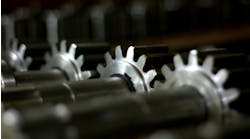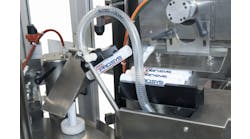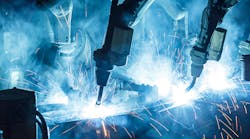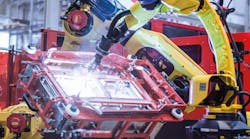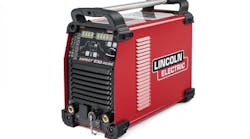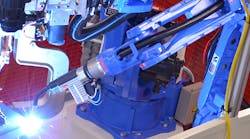No matter the manufacturing industry, company size or part dimensions, the purpose of robotic welding is the same: to produce high-quality welds in the least amount of time.
While there may be a bit of a learning curve when it comes to reaching optimal weld quality and cycle time, the following weld functions are available to take your weld process to the next level.
1. Collision Detection
This is a standard function that will stop the robot if it over torques one of the axes.
Yaskawa robots are shipped with a setting that is approximately 1/3 of the sensitivity. Users can “tune” the function to their application by refining the settings based on their actual application, making the software more responsive to better protect the robot and tooling.
2. Tool Weight and Gravity Measurement
If you have seen messages for Tool Weight and Gravity Measurement scrolling on the bottom of your pendant, you're not operating at peak efficiency. The Tool File contains the information for your Tool Center Point (TCP) dimensions, which are critical for circular and interpolated motion, but there are also settings for Tool Weight.
The robot has a routine where it automatically detects the weight of the tool and its offset by bending it up and down and rotating it 90-deg. before repeating the motion. This will populate the Tool Weight field and generally allow faster motion, rather than assuming the Tool Weight is the worst case for a maximum payload of the robot (what it does if data is not populated).
3. PAM (Position Adjustment Modification) Function
This allows program points to be adjusted during Playback mode without stopping production. It does require some preparation; knowing the step numbers for weld locations in the program and the orientation of the points in order to specify a numeric offset.
Creating a “map” of the welding program—noting the sequence and location of program points—is always a best practice for documentation and supporting a work cell with multiple personnel.
Up to 10 points can be offset at a time in X, Y, and Z directions relative to a specified frame. Travel speeds can also be adjusted by entering a percentage (80 to 120%). The updates can be made immediately in Teach mode or take effect on the next cycle in Play mode.
4. Weld Line Shift Function
This is another method of introducing offsets to weld locations to account for stamping runs or other production variations. It includes a shift amount in relation to the joint coordinates (upper leg or lower leg) and is set in the Arc Start File. It will shift all weld locations that use that Arc Start File, and It will shift all points between the ARCON and ARCOF instructions. There is a Shift Cancel Function under the Utility menu if the program needs to be verified without the shifted amount applied.
5. I/F Panel
Yaskawa has incorporated I/F Panels as a way of reporting welding feedback with several of our interfaces. Once an option, this function is now standard on most welding systems. It is an easy way to create “dashboards” to report the status of the system to operators. Items like part counters or I/O Status for clamping could be included.
6. Logging Function
While an optional function on older robot controllers, the Logging Function was made standard on the DX200 controller, and it continues to be a standard function on all newer Yaskawa robot controllers, like the YRC1000. The function has a set-up screen, which allows users to define what events they want to log on to the system with date: timestamps.
While the default setting is to record all events, users may want to limit the logging to program changes, file changes, etc. The system saves the last 200 changes, so the reduced events will let a user go back and review changes over the last couple of shifts that may have impacted a change in operation status. When combined with the optional Password Function, it will log the USER ID that made the change.
7. UNDO Function
This is a standard editing function that simply needs to be enabled. It will keep a temporary memory of changes that will let a programmer restore some data that may have accidentally been deleted and needs to be recovered. If you’ve found yourself saying, “Oops,” while programming, you probably wished you had this enabled.
8. Parallel Shift and Mirror Shift of Jobs
These functions under the Utility menu can reduce programming times—copying jobs to multiple locations or from side A to side B of a positioner.
Parallel Shift allows a range of points to be selected to shift, so the start and end can remain the same, or just sections of the program can be offset. A Teach Setting makes it easy to measure a shift amount by recording the difference from the original taught position (source) to the new desired location (destination).
The Mirror Shift function is a utility with multiple robot systems that allows a Job to be copied from one robot to another, reversing the wrist orientation. This is convenient for symmetrical parts where the robot is working on the right-hand and left-hand sides of a part that are identical, except for mirrored orientations.
Welding and fabrication are complex processes that can greatly benefit from robotic automation. While each application will differ in complexity, consistent and effective use of certain weld functions can improve quality, enhance productivity and decrease costs.
